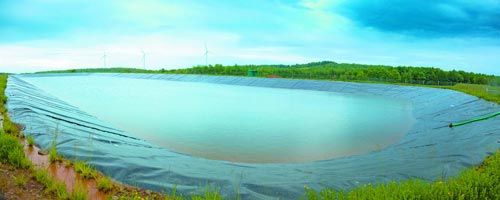Identifying Fracking Contamination of Drinking Water Using GC×GC–TOF-MS
Fracking activity in the northeast of the USA has rapidly increased over recent years, with over 8000 Marcellus wells drilled in the Marcellus Formation in Pennsylvania, USA, alone. Scientists in Pennsylvania investigating an isolated contamination incident have published data from their study, demonstrating the application of comprehensive 2D gas chromatography coupled with time-of‑flight mass spectrometry (GC×GC–TOF-MS) to investigate fracking contamination in a drinking water source.
Fracking activity in the northeast of the USA has rapidly increased over recent years, with over 8000 Marcellus wells drilled in the Marcellus Formation in Pennsylvania, USA, alone.1 Fracking is attracting more media attention because it opens up more natural resources but has also been associated with environmental contamination. Scientists in Pennsylvania investigating an isolated contamination incident have published data from their study, demonstrating the application of comprehensive 2D gas chromatography coupled with time-ofâflight mass spectrometry (GC×GC–TOF-MS) to investigate fracking contamination in a drinking water source.1
Photo Credit: Dwight Nadig/Getty Images

The study published in the journal PNAS reports that in 2011 the Pennsylvania Department of Environmental Protection (PADEP) documented the contamination of an aquifer used as a source of drinking water with natural gas from Marcellus Shale gas wells. In the year prior, three households discovered white foam in their drinking water wells drawn from an aquifer, and subsequent analyses performed by regulators detected natural gas contamination, thought to be attributable to the drilling of new gas well pads. The regulators were not, however,
able to determine the cause of the white foaming. In 2012, the company responsible for the gas well leak acquired the three households affected by the drinking water contamination.
Co-author Frank Dorman from Pennsylvania State University told The Column: “We did the work because we were initially interested in the potential for source identification and apportionment in the event of an accidental discharge of the fluids used in the drilling industry. Our opinion was that this needed to be done in a ‘true discovery’ approach, because there is really little to no disclosure as to what exact chemicals are used at the potential sites. This was especially true when we started this work ~5 years ago.”
The team performed GC×GC–TOF-MS analyses on water samples collected from one of the originally contaminated wells, two of the replacement wells that were drilled as a replacement for the homeowners, a natural spring, and water wells near the contaminated area. GC×GC–TOF-MS analyses detected an “unresolved complex mixture” (UCM) of over 1000 different hydrocarbons in the contaminated samples that was similar to the UCM of hydrocarbons profiled in flowback/production water provided by other gas fracking companies in the area. The commercially available shale gas-drilling additive, 2–BE, was also detected at low levels in the contaminated water samples.
Dorman told The Column that the UCM “signature” detected in the flowback/production and well samples could be used as a diagnostic to detect the impact of shaleâgas operations on surface or groundwater. He said: “We are continuing to work on being able to quantitatively describe the hydrocarbon signatures using GC×GC–HRTOF-MS through the development of massâdefect plots (Kendrick diagrams), and then hopefully developing the ability to determine goodnessâof-fit of the hydrocarbon signature of reference samples to field samples.”
In an FAQ document published by the authors, they state that it is not possible to “unambiguously” determine the source of the 2-BE or UCM in the drinking water, and that the gas company responsible for the leak has since made changes to gas well construction practices.2
In terms of future work, Dorman explains that the team are exploring the possibility of bioremediation to remove organic content prior to recycling of water at the well sites. - B.D.
References
1. G.T. Llewellyn et al., PNAS 112(20), 6325–6330 (2015).
2. FAQ Document: http://www.appalachiaconsulting.com/home/whats_new/pnasarticlefaqs

Accelerating Monoclonal Antibody Quality Control: The Role of LC–MS in Upstream Bioprocessing
This study highlights the promising potential of LC–MS as a powerful tool for mAb quality control within the context of upstream processing.
Using GC-MS to Measure Improvement Efforts to TNT-Contaminated Soil
April 29th 2025Researchers developing a plant microbial consortium that can repair in-situ high concentration TNT (1434 mg/kg) contaminated soil, as well as overcome the limitations of previous studies that only focused on simulated pollution, used untargeted metabolone gas chromatography-mass spectrometry (GC-MS) to measure their success.
Prioritizing Non-Target Screening in LC–HRMS Environmental Sample Analysis
April 28th 2025When analyzing samples using liquid chromatography–high-resolution mass spectrometry, there are various ways the processes can be improved. Researchers created new methods for prioritizing these strategies.
Potential Obstacles in Chromatographic Analyses Distinguishing Marijuana from Hemp
April 28th 2025LCGC International's April series for National Cannabis Awareness Month concludes with a discussion with Walter B. Wilson from the National Institute of Standard and Technology’s (NIST’s) Chemical Sciences Division regarding recent research his team conducted investigating chromatographic interferences that can potentially inflate the levels of Δ9-THC in Cannabis sativa plant samples, and possible solutions to avoid this problem.

.png&w=3840&q=75)

.png&w=3840&q=75)



.png&w=3840&q=75)



.png&w=3840&q=75)








